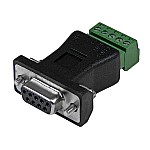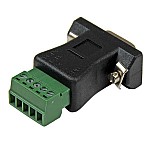NMEA Input options
Any standard NMEA 0183 feed can be connected to the Red Box via the USB connector. One such NMEA feed is supplied as standard in the box, in that there is a USB GPS "dongle" included. So you can connect:
- NMEA 0183 feeds from Raymarine, Garmin, Furuno, etc.
- NMEA 0183 feeds from an NMEA2K convertor (or seatalk convertor)
- GPS feeds from USB dongles
- AIS feeds either via NMEA 0183 serial, or most forms of USB input
The NMEA feed(s) can be at any of the standard NMEA speeds, ie 4,800 baud or 38,400 baud.
Connecting NMEA 0183 to the Red Box
In theory NMEA 0183 is defined as being an RS422 interface, however, we observe that many (if not most) NMEA labelled outputs are in fact RS2332 and therefore connected via a standard serial to USB adaptor (but check with the manufacturer in case you require an RS422 to USB adaptor. Both are inexpensive adaptors and generally fairly easily available (or purchase directly from us).
All that is required to hook up a new NMEA 0183 feed is to connect the USB adaptor (RS232 or RS422 as appropriate) to a USB port on the Red Box. It will take around 5 seconds for the device to be probed and identified and after that point it's NMEA data will be merged (multiplexed) with any other NMEA feeds into a single output NMEA feed that is available over the internal network.
Note: It's not a problem to connect multiple NMEA feeds, each potentially running at different speeds, to the Red Box. All the feeds will be multiplexed into a single NMEA output feed. Additionally you can have (practically) unlimited listeners monitoring this combined output feed.
You may find it helpful to purchase a DB9 terminal block adaptor from us:


Getting NMEA data into Windows XP, Win7, Win8, etc
Most windows navigation/weather applications don't seem to natively accept NMEA/AIS data over the network, but there are a number of freely available applications which will emulated a serial port. This means that any program which can accept navigation data from an ordinary serial port can now read the data from the Red Box (over the wifi/wired network)
One which has been tested by many customers is "HW VSP3" produced by http://www.HW-group.com. Download the "Single Port" version from the link below. Installation instructions are further down the same page:
Once installed, configure it with the following settings:
- Server: 192.168.111.1
- Port: 10110
Getting NMEA data into Apple Mac OSX
Some Mac OSX applications appear to be able to accept NMEA/AIS data directly from the network. Simply enter the following settings into your navigation application (eg GPSNavX)
- Server: 192.168.111.1
- Port: 10110
Getting NMEA data into iPad/iPhone/Tablet
Several iPad applications have an option to accept an NMEA feed over the wireless network. Applications we are aware of include:
- iNavX
- NMEARemote
Enter the following settings into those applications:
- Server: 192.168.111.1
- Port: 10110
Raymarine NMEA 0183 wiring
Raymarine tell us that most of their NMEA0183 equipment uses RS232 (not RS422) and hence the wiring would be
| Equipment | RS232 | Our adaptor |
| NMEA+ | pin 2 on RS232 | "T+/D+" |
| NMEA- | pin 3 on RS232 | "R+" |
| GND | pin 5 on RS232 | "GND" |
RS422
Some manufacturers (correctly) use RS422 from their equipment. This means that instead of one wire for transmit and one wire for receive, instead you have a pair of wires for each. The motivation is that by looking at the difference between the pairs, rather than the absolute level, you have significant resistance to noise and interference
If you have an RS422 termination then you should use a USB to RS422 adaptor. However, although incorrect, many customers report they can get away with using the "wrong" RS232 adaptor... Please try and order the correct adaptor though.



